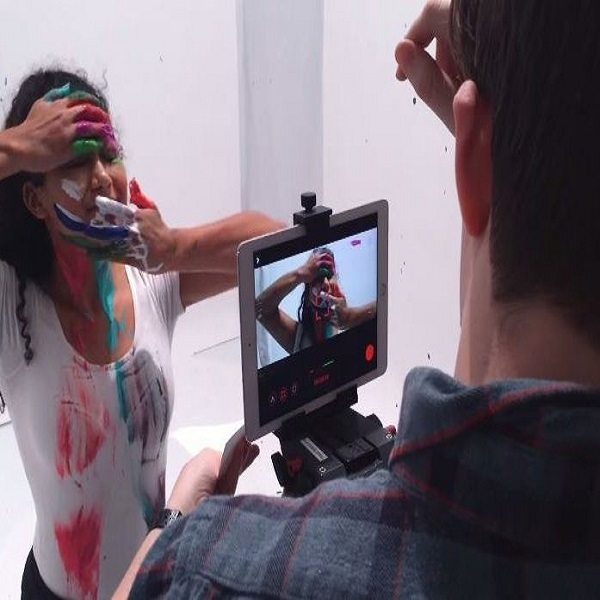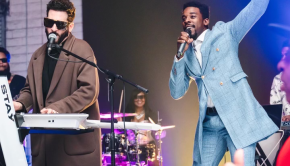Public High School Making Noise In Hollywood With New Program Director Drew McClellan
When it comes to performing arts high schools, most people know the New York FAME school from movies and the iconic Debbie Allen as the stern dance teacher from the 1970s show of the same name, “You want fame? Well, fame costs.” Nowadays, Los Angeles has emerged with one of the must-see top art schools in the country with The Los Angeles County High School of the Arts (LACHSA), ranked #3 by Niche for 2018. Housed in a 31 million dollar, the three-level state-of-the-art facility completed in 2013, LACHSA has long been nationally known for its excellent dance, theater, and visual arts programs. These programs send next-generation theater and music stars to Julliard and Berklee College of Music and produced notable alumni such as Josh Groban, Anthony Anderson, Jenna Elfman, Corbin Bleu, and Christina Milian. However, LACHSA is gaining national notice for one of its newer departments: The Cinematic Arts program. LACHSA Cinematic Arts was featured during this year’s 75th Golden Globes special as an example of exemplary high school arts education.
In 2017-2018, the LACHSA Cinematic Arts program is helmed by former USC, M.F.A graduate, Drew McLellan. McLellan, a talented filmmaker who specializes in branding, is helping turn LA county students into top-notch next-generation filmmakers, as well as fostering an entrepreneur mindset in cinematic arts majors to learn how to market and create businesses to support the art they love. In the master class, juniors and seniors get first-hand industry knowledge from VIP Hollywood pros. In only a few short years, students from LACHSA cinematic arts have started to sweep local and college film festivals. The cinematic arts program is doing so well other prominent high schools have taken notice, and one elite private school reached out for insights into building their film program. Word on the street is, major Hollywood players are also taking notice and sending their talented offspring to the film program. Recently, McLellan sat down and offered great insights into what drives LACHSA’s cinematic arts department success in the Q&A below:
The 2018 rankings for Arts Schools were published by “Niche” and LACHSA ranked #3 in the nation and is #1 in the West. LACHSA Cinematic Arts Is making noise, what makes the program special?
There is not a cinematic arts program at the high school level that is this close to the industry. LACHSA is in the backyard of Hollywood, which is the epicenter of entertainment and media. The access to many creative professionals in the sector spills over into our department. We have working film professionals on the cinematic arts faculty. Also, there are a lot of parents of students that currently work in the entertainment industry, who are willing to provide knowledge, opportunities, and exposure to our students as well as the faculty. Those two components separate us from any other institution that might be in existence for the film at the high school level. Not to mention, we have some of the most talented artists in other departments and can integrate interdepartmental collaborations at a high level, such as film score from the music department and dance prodigies or visual artists to collaborate on screen for projects. No other school can do it at the level we achieve.
What are some of the requirements to attend this prestigious institution?
It is a public school and completely free. The institution is in a district run by the Los Angeles County office of education located on the campus of Cal State Los Angeles. They have two locations, LACHSA and International Polytechnic High School. Poly is the STEM School and specializes in math and sciences. The requirements for LACHSA are that you have to audition to gain entry. This task has become rigorous and competitive in all majors. Cinematic arts students have to submit a short film to be considered for the program. Students also have to send in a letter of recommendation and a write an entrance essay. The essay roughly centers on the students’ passion and why the student thinks he or she would be a good fit for the program. After the student sends in all of the required material, we will call you in for an interview with alumni, faculty, possibly myself, and a panel of other individuals.
What are the hours of operation?
The way the program works is at 8 A.M to roughly 12:30 the students are in their academic courses. That includes reading, writing, math, science, and liberal arts. After 12:30, the students break and start attending their art classes in their majors. So, here at the school, we have six departments: music, musical theater, theater, visual arts, dance, and cinematic arts. I am the Senior Program Specialist, and I oversee the department of visual arts and cinematic arts. Cinematic Arts is my primary focus, and I share oversight of the division with two other co-chairs in the visual arts department. There are roughly 200 students enrolled in both sections. This year will be my first in my new position. I was a part of the teaching staff last year. Our grade levels are 9th through 12th and through the first couple of years the students are learning the basics; meaning how to take care of the equipment, how to identify the equipment, and learning master shot grammar, lighting, sound, and about lenses.
What is your educational background?
My background is in narrative film. I obtained my M.F.A from USC Cinematic Arts School in directing and production. I attended Howard University in D.C. for my undergrad, and my major was in English with a minor in film production.
What universities have some of your alumni attended upon completion of the program?
This will be the fifth year that cinematic program has been in existence and we’ve had our former students go on to attend NYC film school (five students), USC film school (one), and Chapman film school (one). So, our students go on and attend some of the top institutions in the nation.
What are some of the events that the cinematic program will be involved in this year?
We have several film festivals throughout the year. We had one in September, the 64-Hour Film Festival, that was extremely well attended, and the students demonstrated a strong sense of craft and creativity. One of the films from that festival was highlighted during the 75th Golden Globes special because of the high quality of the work. We also had a film festival for Halloween earlier this year, and our students had the opportunity to showcase their talents and demonstrate some of the knowledge on the screen that they have learned so far in their courses. We are having our first music video film festival this February. There are some other projects that we are currently discussing, but there is nothing set in stone yet. Finally, at the end of the year, we have a film screening of all the projects that the students have been working on, and this is an opportunity for them to have it on the big screen at the Alex Theather in Glendale, California.
What other tools will you utilize to showcase the content of the program?
The LACHSA website is where you go to find out all the information about the program. Also, Apple decided to use our students in a commercial featuring the iPad, and Martin Scorsese was narrating the commercial. We are currently redesigning our Vimeo, YouTube platform, SoundCloud, and podcast.
What exactly are cinematic students learning?
They are learning all the components of the cinematic arts which includes writing, story structure, critical analyses of films, producing, film grammar, aesthetics, collaboration, on-set etiquette, and the practice of hands-on learning. Then, they learn through hands-on application how to execute these techniques into their production projects. LACHSA has access to several different cameras that start from the most basic semi-pro cameras to the industry professional Red Epic Camera and Blackmagic URSA. The professional equipment is used in our students’ film productions and music videos. Also, our students have access to all of the equipment and camera packages during their art classes and outside of class time as long as they are enrolled at the institution. We are also teaching them that they will have to be innovative, become entrepreneurs so they can have the means to pursue their art, whether it’s learning marketing skills to raise money or creating their businesses—which some already have—to capitalize on their skills or maybe its creating viral content to monetize. We are honest with the students’ teaching them that entertainment is a business, it’s exciting, and it’s fun, but at the end of the day, we want to arm them with tools for success, which means learning creative ways to earn capital to make the movies or TV content they want or learning how to pitch well to get projects sold.
How do you foster creativity in the students?
We encourage our faculty to ask students what their passions are to help steer them in the right direction as it pertains to their creativity as content curators. We handle our student’s creative strategy by using the case-by-case method, and once we assess those challenges, then students already come to the table with a variety of ideas. Innovation is encouraged on all levels, from teaching strategies to developing and supporting students’ creative ideas. The process of fostering creativity has never really been an issue, as we foster their knowledge in the filmmaking craft and since we evaluate their creativity and potential in the admissions process, once it is complete it is our job as faculty to help mold, shape, and give them the tools they need to succeed. We, of course, help them with strategies, such as brainstorming, pitching ideas, and learning the basics of craft from which to explore creative approaches to ideas. This helps. The whole process allows students to be able to express themselves, but also learn what is realistic regarding execution, and we encourage them to help one another and to work as a team to foster creativity, problem solves, and complete tasks.
LACHSA is the top-rated performing arts school on the West Coast, what advantages does the Cinematic Arts program have being in LA? Can you give a few specific examples?
Number one is access to Hollywood, the industry, and the fact that some opportunities are available in Los Angeles that are not available in other places, such as, the music industry, entertainment industry, live performances, and industry mentors. Everything in the entertainment industry comes through Los Angeles at a certain point. During my time here at LACHSA, there have been a lot of students that decided to attend college in other states because what they are familiar with is on the West Coast and they wanted to broaden their horizons. But for the most part, what makes Los Angeles attractive for those who don’t live here is the industry, because individuals interested in movies think they will come out here and be close to the industry and achieve success. Moving out to Los Angeles without a company, job in place, or occupation to be a part of, without an established creative community, is not the right strategy. Moving to Los Angeles without a network, when you have to try to pursue a career in the entertainment business, is the wrong plan. It would be a better decision to make sure there is something available and then take the proper steps through relationships to pursue a career. Students at LACHSA are right here, surrounded by the industry, from faculty to their peers and parents, and they build a network and a community. Even when students graduate from LACHSA and move to another state to pursue a film education, they already have four years of significant relationships and contacts with talented peers and industry professionals. This provides them with a huge advantage of skilled, talented entertainment relationships in a tough industry that runs on personal contacts.
Representation and inclusion are significant issues in Hollywood, how is the diversity of voices, images, and opportunities addressed in LACHSAs Cinematic Arts department?
That is something that I am working on to include in this program to allow diversity and giving each of the opportunity to have their voice. The students already have their own “Representation Matters” movement, and when they work on teams and produce, they are filling that mission on their own through raised awareness that was initiated by their peers. There is not any magic to becoming a filmmaker, that notion is a part of a façade that directors, actors, and writers perpetuate. This façade that these creatives eat a different diet or they were born a special way with a special talent. No, these individuals have an interest, and they were taught how to tell a story visually at an early age or learned how to master their craft on how to be a filmmaker from an experienced family member or mentor. So I believe that everyone has a story to tell, no matter their age, ethnicity, gender or culture and telling those stories well starts with learning what the components and stages are that go into the storytelling process. If a student, regardless of their background, is determined and open to learning the craft of written and visual storytelling, willing to learn how to write, edit, and shoot properly, any individual who has an interest in learning how to do those type of things properly, we welcome them at the LACHSA Cinematic Arts department. We want any student, regardless of background, who is creative, willing to work hard, and open to learning the proper techniques to make them successful in the entertainment industry.
What is the dream vision you and LACHSA have for the Cinematic Arts Department?
My goal is to make the Cinematic Arts Department at LACHSA the go-to pipeline for cinematic arts departments at top universities around the world. I want to create a platform for students or families who have aspirations of their children to attend top cinematic arts institutions, like USC or NYU, I want the first place they think of to be the LACHSA Cinematic Arts Department and liberal arts program. I want students to be able to attend the top film school’s in London, Milan, or Paris. I was an English major, my minor was in the film, and I know for storytellers and individuals who want to pursue a career in the entertainment business you need to possess a wide range of knowledge and exposure. If you only study certain movies, then that will be the only content you can create, but if you have a wide knowledge of content and experiences, you will never get stagnant when it comes to material. The Cinematic Arts Department at LACHSA is built on that foundation and allows our students to tell stories and then go off and study things that highlight our existence on the planet and share it cinematically with the rest of the world in a creative form to hopefully build a professional career off of that material. My goal is to create a top-notch program that prepares young filmmakers, storytellers, and creative professionals for a career in the entertainment industry.
What kind of equipment is available to students to learn with and how necessary are the right industry materials for teaching students?
The equipment is critical for student learning, development, and growth. We have a great number of cameras available for students to learn the craft of filmmaking, so they are learning experientially and not just theoretically. Students learn to write in a program called Final Draft, which is industry standard, and they also cut on Adobe Premiere which we make available on our studio computers for any student to use at any time. As I mentioned previously, students can film with a variety of different cameras. For example, they use the Red Epic, Sony H7S, Black Magic URSA, and Canon D5. Students film in our cinematic program, it’s not a situation where they are waiting months and years. They are filming sometimes weekly. So, we have a diverse arsenal of camera equipment, grip, and lighting packages, and we encourage innovation which includes using an iPhone if necessary. When the new building was built, the department received a grant that allowed us to purchase the equipment that was needed to help our students succeed. We also use all of the Adobe software like Photoshop allowing our students be very creative with their content.
What’s the quality of the films made and are you finding untapped talent?
When I first started teaching at LACHSA after graduating from USC’s Graduate School of Cinematic Arts program, the first film festival was the 64-Hour Film Festival. I attended the top film university in the nation and honestly, I was blown away by the quality of the content these students were creating, and I say this in all honesty because the top high school films rivaled the content that my fellow graduate students were creating at USC. A lot of these films could have been submitted for a graduate level showcase at USC Film School and no one would have thought it was made by high school students. We have students from our program getting into the top film schools in the world and getting accepted into major film festivals gaining national recognition. These cinematic arts students at LACHSA truly are the next generation of untapped filmmaking talent.
What is the LACHSA Cinematic Arts Master Class?
This a class that is run by Dr. Anita M. Cal who is one of the cinematic arts faculty and it happens every Friday afternoon for the juniors and seniors. We bring in industry professionals like Niki Caro (Annie With an E) and Mandy Walker who is a cinematographer, and she shot Hidden Figures. Both individuals will be collaborating on the new Mulan movie for Disney that is slated to be released in 2019. We have also had Bobby Shore who is also a cinematographer, and his work includes commercials, TV pilots, feature films, and music videos. The class gives our students an opportunity to have facetime with these top industry professionals and ask questions about the filmmaking craft. The guests also provide instruction on how they achieved the look of their films, the lenses they used, the lighting setups, etc. while also sharing their stories about obstacles they faced while pursuing careers in the industry. Dr. Cal does an excellent job moderating, and it is like the department’s version of Inside the Actors’ Studio, but we are not limited to just actors but all sorts of entertainment industry professionals.
Follow LACHSA At The Links Below
Tweet


































